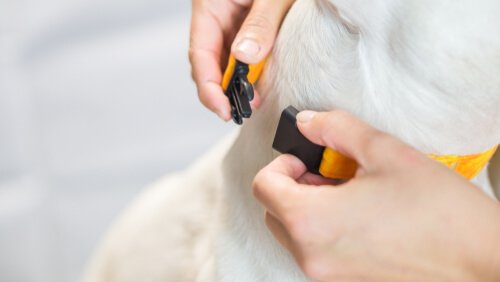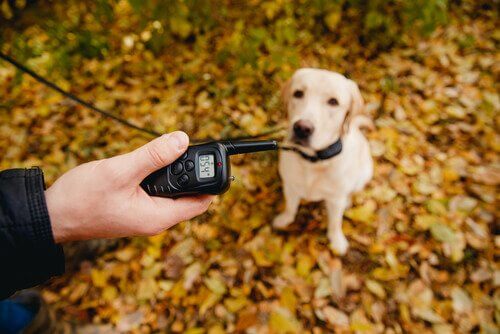Anti-Bark Collars: Everything You Need to Know

Dogs are seen as one of the most loyal, noble pets. However, despite all the many amazing qualities they have, there are also some things about them that can be very annoying. You don’t have to think too long to guess one of them: barking. The pet market has come up with a solution: anti-bark collars. We’ll give you the low down on them in this article.
Anti-bark collars: what are they?
Anti-bark collars are a device made to stop dogs from barking. Here’s how they work. Like other collars, you put these around your dog’s neck. But these ones have a receptor in them that can detect movement in your dog’s throat. Depending on the type of collar, it will do something specific to your dog.
But you have to remember that the throat is one of the most delicate parts of a dog’s body. The potential health impacts of something like this can be very serious.

Types of anti-bark collars
There are several types of anti-bark collars, but here are the most common:
Spray
Anti-bark spray collars go around your dog’s neck. When it barks, the receptor in the collar picks that up and sends a signal. The signal then activates the spray, located beneath your dog’s snout. That surprises your dog, and it has to react with four different senses: sight, smell, touch, and sound.
Several studies have come to the conclusion that in 28% of cases, these collars can partially eliminate barking. In 70%, barking stops entirely. This is the least harmful kind of anti-bark collar out there.
It has no direct effect on your dog’s body, and just sprays out a harmless liquid. Using one with citronella will bother your dog without actually hurting it.
Shock
A shock collar is very similar to the idea of a spray collar, but this one only involves your dog’s sense of touch. The moment your dog barks, the collar sends out an electric shock that works as a punishment for its behavior.
If you choose this kind, you need to get one with an adjustable shock level. Every dog has a different level of sensitivity, just like humans.

The shock tends to be automatic, and will vary depending on the strength and frequency of your dog’s barks. This is why it absolutely needs to be adjustable. It’s also best not to have the collar on your dog all the time, because the shocks can cause skin necrosis.
Limitations
All anti-bark collars have their limitations in terms of effectiveness. Your real goal should be to address the cause of the barking. Look at it as the symptom. You’ll be stopping the barking, but not solving the root problem.
For example, some dogs may stop barking and start destroying the things around them, urinating where they shouldn’t, or even harming themselves.
Identifying the cause of the barking
Before you make your decision about whether or not to use one of these, you should start by figuring out why your dog barks. They actually do it for many different reasons and emotions: joy, excitement, concern, etc…
The barks always have some kind of message to express. Some specialists see them as a “way for them to release stress and boredom.”
If you want to figure out what exactly is making your dog bark, keep reading to see a potential list of the causes:
- Boredom: a dog might bark to attract company, as a reaction to the stress of being alone.
- Vision: if they take an interest in people, dogs, or other animals passing by, then your dog may bark to try to communicate with them. It could also be a way to express frustration.
- Sounds: your dog picks up all kinds of sounds throughout the day, and reacts to them in different ways. If it’s the sound of the door opening and its owners coming in, then it will bark out of joy.
- Attention: it wants to get your attention, and barking is the best way it can think of to do that.
- Compulsive behavior: it’s possible that your dog barks when it’s uncomfortable, or that it has simply become a habit.
- Fear: some dogs get afraid when they’re by themselves, and they bark as a way to calm themselves down.
Another potential option is that your dog is just talking to you, trying to express itself.
Conclusion
There’s one conclusion in particular that you should take from everything we’ve told you today. The anti-bark system isn’t necessarily a positive thing for your dog, and can potentially have negative consequences. There are many other therapies and alternatives you can explore to solve the barking problem.
All cited sources were thoroughly reviewed by our team to ensure their quality, reliability, currency, and validity. The bibliography of this article was considered reliable and of academic or scientific accuracy.
Desachy, F. (2009). Mi perro ladra mucho ¡Hay solución! (S. A. (10 de septiembre de 2009) DE VECCHI EDICIONES, Ed.). Retrieved from https://books.google.es/books?id=nmiKDwAAQBAJ&pg=PT50&dq=collar+antiladridos&hl=es&sa=X&ved=0ahUKEwiOop2R5eHgAhUQJhoKHfPsDTkQ6AEIKDAA#v=onepage&q=collar antiladridos&f=false
Sentelles, E. I. (2014). La regulación de los collares dañinos : avanzando en el bienestar canino, 1–3.